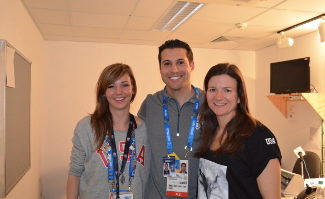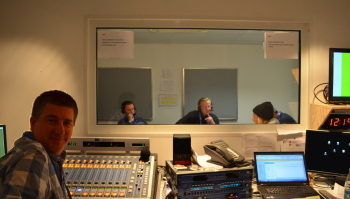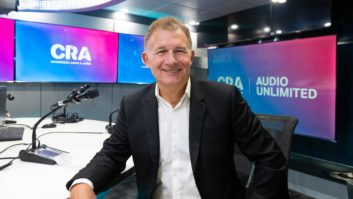NEW YORK — Like gymnasts coming off the uneven parallel bars, Dial Global Radio Network engineers and technicians hope to “stick the landing” following lengthy preparations for coverage of the 2012 Summer Olympics in London.
The road to England began months ago for the radio network, with studio measurements, diagrams and technical planning. In fact, much of the radio network’s technical infrastructure was pre-assembled in New York for shipment in advance of the July 27 opening ceremony.
To provide the technical expertise for what basically is a two-week live remote, Dial Global engineers and technicians tackle numerous tasks ahead of time, said Mitch Glider, vice president of engineering at Dial Global, New York.
“We build, design, stage and test all the equipment in New York City at the [Dial Global] Broadcast Center, so once we get onsite we don’t have guys out there with soldering irons and crimping tools.” The planning process started about a year ago once Dial Global secured the rights for the London games, according to Glider.

Photo courtesy of Mitch Glider. Dial Global acquired the radio rights to the Olympics as part of its merger with Westwood One Inc. last fall.
The radio network’s on-site operation will be based within the International Broadcast Center at the Olympic Park. Dial Global will occupy just a small part of NBC Television’s 65,000 square feet space within the IBC. Several control rooms and associated studios will be used by the radio network in addition to broadcast capabilities at five Olympic venues.
The infrastructure shipped to London by Dial Global consists of ten fully loaded road cases and at least a half-dozen miscellaneous equipment boxes, Glider said.
Dial Global will provide its affiliates exclusive coverage of the Olympic Opening and Closing Ceremonies, two-minute updates three times an hour 24/7, a two-hour nightly Olympic wrap-up show and long-form coverage of several sports, including men’s and women’s basketball and women’s soccer.
The five hour time difference between London and the United States’ Eastern time zone will present some programming challenges for Dial Global, Glider said.
“We always strive to bring as much live programming as possible. There will be some pre-taped elements to our long form coverage,” he said.
Glider said once onsite surveys at the IBC were complete he began his preparations with a simple scale drawing of the physical space. The drawing, done by Glider in Visio, a diagramming software program from Microsoft, is followed by more steps to add additional layers of studio equipment and furniture in each diagram.
EQUIPMENT SELECTION
“It all starts by drips and drabs. Equipment selection is crucial,” said Gilder.
“The engineering department will look at the scope of work to do in terms of IFB communication, editing ability and stuff like that,” he added. “There are always new challenges. We need the ability to have one central core routing system to tie our consoles and intercom system together. We have five venues and need to communicate with them over intercom.”
Dial Global relies heavily on Sierra Automated Systems and its routers, Gilder said, and works with the company on custom products and specialized products.
“We have a SAS 32KD router and Rubicon-SL consoles, Rubi/T mini-console control surface and ICM 32 intercom heads,” said Glider. “We’re using a new product of theirs called SAS Soft Panel Suite, which is a suite of software that allows you to do pretty much anything as a piece of hardware via computer. We can point any venue to any console or even right back to New York,” he said.
Dial Global will use Telos Zephyr Xtreams for all ISDNs and Comrex Access IP codecs. ISDN is the preferred method for transporting live audio since Internet codecs present latency issues and shared Internet connections often times are unreliable, Glider adds.
Dial Global’s remote system mobile racks are pre-wired with Cat-5E and multi-pair Cat-5 cable, Glider said, and use custom interface boxes and breakout panels manufactured by Whirlwind.
“Therefore we can carry both computer LAN and the SAS audio and data is backwards compatible via RJ-45 cable.
“That is what makes it unique to us. We are using patch panels and not punch blocks. Everything is RJ-45 wiring. It’s an all RJ-45 cable system,” Glider said. “The focus is on Cat-5E…zone Cat-5E with modularity.”
Dial Global will use three different studios in the IBC: a control room and two other small studios for recording. All three will feature Dixon NM-250 MKII mixers and Telos HX-1 hybrids. Natural sound will be provided by the host communications provider and mixed in the on-site studios, Glider said.
WORRIES ABOUT TELECOM
Glider is familiar with the needs and challenges an Olympic Games present; he has engineered for Olympics coverage dating back to Salt Lake City in 2002.
“The main worries I have is telecom, from the ISDN, T-1 even analog POTS lines we use for emergencies and interviews. One of the reasons why we spend so much time organizing ahead of time is that we know the telecom may fail us at some point, either at the IBC or at the venues,” Glider said.
The combination of mechanical, logistics and usage is responsible for telecom issues, he said. The sheer scope and diversity of the services provided combined with being in a foreign country can create telecom issues.
“Unfortunately we cannot test the telecom on site until several days before the games begin. Then we’ll check them every day for noise floor and continuity. We carry McCurdy extended-range test sets to constantly monitor the four-wire connections between the venues and the IBC,” Glider said.
Dial Global’s 35 x 22-foot space within NBC Television’s complex will house a small master control and several auxiliary studios, Glider said. Short radio packages will be mixed and produced onsite and at Dial Global’s New York City broadcast center. Producers in New York take the source analog audio and insert commercials and then direct the audio through the multichannel network Harris automation system to the external routing system. The Olympic feeds are sent to affiliates via satellite uplink from New York.
Dial Global sports anchors and reporters will carry Marantz PMD 620 hand-held digital recorders and use portable Comrex Access units to connect to the IBC or directly to New York operations.
Dial Global, which relies on NBC Television for its telecom, electrical and video service needs, will uses Furman AR-Pros AC line voltage regulators to protect its equipment. “All of our equipment is 120 volts at 60 Hz, while the site will provide us with Euro 220 volts at 50 Hz.”
Glider said wireless spectrum in London will be monitored “very closely, be very limited and very expensive” to use.
Glider declined to disclose Dial Global’s technical costs involved with covering the 2012 London Olympic Games.
Dial Global engineers Wally Tienken and Zach Akey are making the trip to London to manage onsite engineering services, Glider said. Meanwhile, Howard Deneroff and Mike Eby are the event’s senior producers for the radio network.
Dial Global provides 200 programs and services to 7,000 radio stations.











